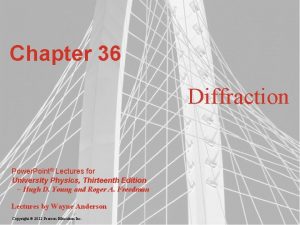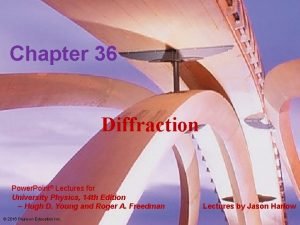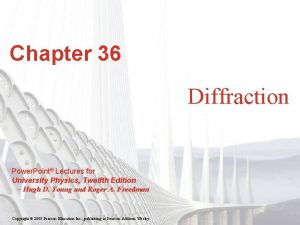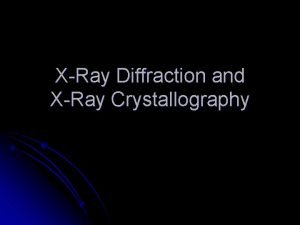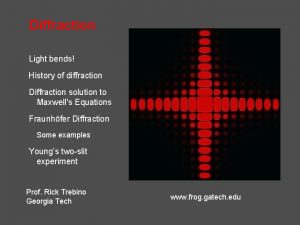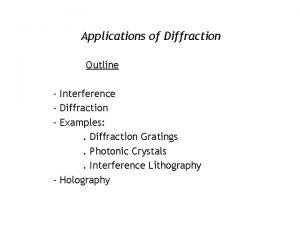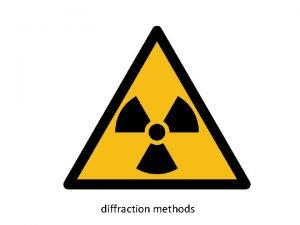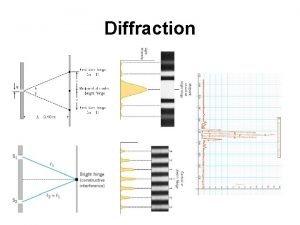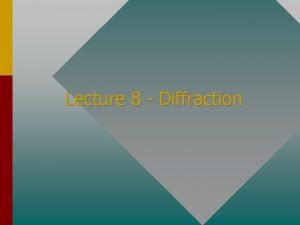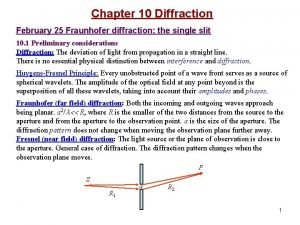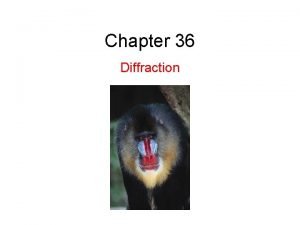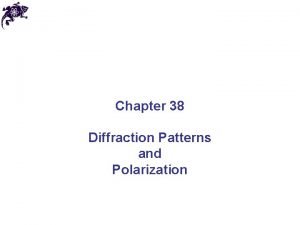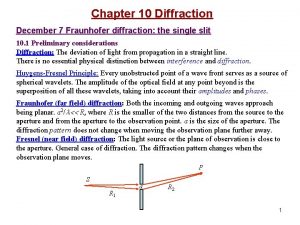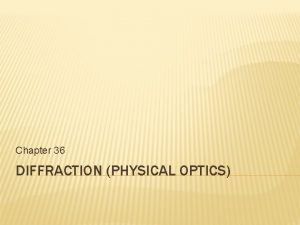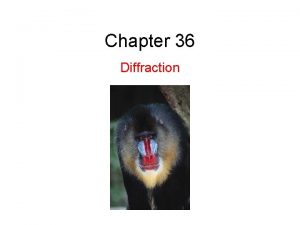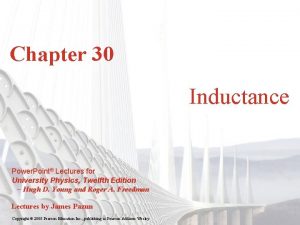Chapter 36 Diffraction Power Point Lectures for University

























- Slides: 25

Chapter 36 Diffraction Power. Point® Lectures for University Physics, Twelfth Edition – Hugh D. Young and Roger A. Freedman Lectures by James Pazun Copyright © 2008 Pearson Education Inc. , publishing as Pearson Addison-Wesley

Goals for Chapter 36 • To define and explain Fresnel and Fraunhofer diffraction • To consider single-slit diffraction • To summarize and then apply an understanding of diffraction gratings • To consider the atomic example of x-ray diffraction • To study circular apertures and resolving power • To introduce holography Copyright © 2008 Pearson Education Inc. , publishing as Pearson Addison-Wesley

Introduction • It’s intuitive that sound can diffract (and travel around corners). Light doesn’t “show its poker hand” so easily. • If you shine light from a point source to a ruler and look at the shadow, you’ll see the edges are … well … not sharp. A close inspection of the indistinct edge will reveal fringes. • This phenomenon may not sound useful yet but stay with us until the end of Chapter 36. This line of thinking has shown the way for advances in DVD technology and applications in holography. Copyright © 2008 Pearson Education Inc. , publishing as Pearson Addison-Wesley

Fresnel and Fraunhofer diffraction • According to geometric optics, a light source shining on an object in front of a screen will cast a sharp shadow. Surprisingly, this does not occur. Copyright © 2008 Pearson Education Inc. , publishing as Pearson Addison-Wesley

Diffraction and Huygen’s Principle • Diffraction patterns can be analyzed as we did in Section 33. 7 using Huygen’s Principle. Recall, every source of a wave front can be considered to be the source of secondary waves. Superposition of these waves results in diffraction. • If the source and the screen are close to the edge causing the diffraction, the effect is called “near-field” or Fresnel diffraction. If these objects are far apart, so as to allow parallel-ray modeling, the diffraction is called “far-field diffraction” or Fraunhofer diffraction. Copyright © 2008 Pearson Education Inc. , publishing as Pearson Addison-Wesley

Diffraction from a single slit • The result is not what you might expect. Refer to Figure 36. 3. Copyright © 2008 Pearson Education Inc. , publishing as Pearson Addison-Wesley

Dark fringes in single-slit diffraction • Consider Figure 36. 4 below. • The figure illustrates Fresnel and Fraunhofer outcomes. Copyright © 2008 Pearson Education Inc. , publishing as Pearson Addison-Wesley

Fresnel or Fraunhofer? • The previous slide outlined two possible outcomes but didn’t set conditions to make a choice. • Figure 36. 5 (below) outlines a procedure for differentiation. Copyright © 2008 Pearson Education Inc. , publishing as Pearson Addison-Wesley

Fraunhofer diffraction and an example of analysis • Figure 36. 6 (at bottom left) is a photograph of a Fraunhofer pattern from a single slit. • Follow Example 36. 1, illustrated by Figure 36. 7 (at bottom right). Copyright © 2008 Pearson Education Inc. , publishing as Pearson Addison-Wesley

Intensity in a single-slit pattern • Following the method we used in Section 35. 5, we can derive an expression for the intensity distribution. Copyright © 2008 Pearson Education Inc. , publishing as Pearson Addison-Wesley

Intensity maxima in a single-slit pattern • The expression for peak maxima is iterated for the strongest peak. • Consider Figure 36. 9 that shows the intensity as a function of angle. Copyright © 2008 Pearson Education Inc. , publishing as Pearson Addison-Wesley

Interference from multiple slits • The approximation of sin θ = θ is very good considering the size of the slit and the wavelength of the light. • Consider Figure 36. 10 at the bottom of the slide. • Follow Example 36. 2. • Follow Example 36. 3. Copyright © 2008 Pearson Education Inc. , publishing as Pearson Addison-Wesley

Multiple slit interference • The analysis of intensity to find the maximum is done in similar fashion as it was for a single slit. • Consider Figure 36. 12 at right. • Consider Figure 36. 13 below. Copyright © 2008 Pearson Education Inc. , publishing as Pearson Addison-Wesley

Several slits • Consider Figure 36. 14 at right. • Consider 36. 15 below. Copyright © 2008 Pearson Education Inc. , publishing as Pearson Addison-Wesley

A range of parallel slits, the diffraction grating • Two slits change the intensity profile of interference; many slits arranged in parallel fashion are now termed as rulings. • Consider Figures 36. 16 and 36. 17 at right. • Consider Figure 36. 18 below. • Follow Example 36. 4. Copyright © 2008 Pearson Education Inc. , publishing as Pearson Addison-Wesley

The grating spectrograph • A grating can be used like a prism, to disperse the wavelengths of a light source. If the source is white light, this process is unremarkable, but if the source is built of discrete wavelengths, our adventure is now called spectroscopy. Chemical systems and astronomical entities have discrete absorption or emission spectra that contain clues to their identity and reactivity. See Figure 36. 19 for a spectral example from a distant star. Copyright © 2008 Pearson Education Inc. , publishing as Pearson Addison-Wesley

The grating spectrograph II—instrumental detail • Spectroscopy (the study of light with a device such as the spectrograph shown below) pervades the physical sciences. Copyright © 2008 Pearson Education Inc. , publishing as Pearson Addison-Wesley

X-ray diffraction • X-rays have a wavelength commensurate with atomic structure. Rontgen had only discovered this high-energy EM wave a few decades earlier when Friederich, Knipping, and von Laue used it to elucidate crystal structures between adjacent ions in salt crystals. The experiment is shown below in Figure 36. 21. Copyright © 2008 Pearson Education Inc. , publishing as Pearson Addison-Wesley

Ionic configurations from x-ray scattering • Arrangements of cations and anions in salt crystals (like Na+ and Cl– in Figure 36. 22 … not shown) can be discerned from the scattering pattern they produced when irradiated by x-rays. Copyright © 2008 Pearson Education Inc. , publishing as Pearson Addison-Wesley

X-ray scattering set Watson and Crick to work • An x-ray scattering pattern recorded by their colleague Dr. Franklin led Watson and Crick to brainstorm the staircase arrangement that eventually led to the Nobel Prize. • Follow Example 36. 5, illustrated by Figure 36. 25 below. Copyright © 2008 Pearson Education Inc. , publishing as Pearson Addison-Wesley

Circular apertures and resolving power • In order to have an undistorted Airy disk (for whatever purpose), wavelength of the radiation cannot approach the diameter of the aperture through which it passes. Figures 36. 26 and 36. 27 illustrate this point. Copyright © 2008 Pearson Education Inc. , publishing as Pearson Addison-Wesley

Using multiple modes to observe the same event • Multiple views of the same event can “nail down” the truth in the observation. • Follow Example 36. 6, illustrated by Figure 36. 29. Copyright © 2008 Pearson Education Inc. , publishing as Pearson Addison-Wesley

Holography—experimental • By using a beam splitter, coherent laser radiation can illuminate an object from different perspective. Interference effects provide the depth that makes a three-dimensional image from two-dimensional views. Figure 36. 30 illustrates this process. Copyright © 2008 Pearson Education Inc. , publishing as Pearson Addison-Wesley

Holography—theoretical • The wavefront interference creating the hologram is diagrammed in Figure 36. 31 below. Copyright © 2008 Pearson Education Inc. , publishing as Pearson Addison-Wesley

Holography—an example • Figure 36. 32 shows a holographic image of a pile of coins. You can view a hologram from nearly any perspective you choose and the “reality” of the image is astonishing. Copyright © 2008 Pearson Education Inc. , publishing as Pearson Addison-Wesley
 Power system lectures
Power system lectures Dispersive power of grating increase with
Dispersive power of grating increase with Power traiangle
Power traiangle Informsu
Informsu Point point power
Point point power Rick trebino lectures
Rick trebino lectures Lectures paediatrics
Lectures paediatrics Data mining lectures
Data mining lectures Medicinal chemistry lectures
Medicinal chemistry lectures Uva ppt template
Uva ppt template Ludic space
Ludic space Activity based approach in software project management
Activity based approach in software project management Molecular biology lectures
Molecular biology lectures Radio astronomy lectures
Radio astronomy lectures Dr sohail lectures
Dr sohail lectures Utilities and energy lectures
Utilities and energy lectures Web engineering lectures ppt
Web engineering lectures ppt How to get the most out of lectures
How to get the most out of lectures Frcr physics lectures
Frcr physics lectures Heel effect
Heel effect Cs106b lectures
Cs106b lectures Rbc formation stages
Rbc formation stages Define aerodynamics
Define aerodynamics Theory of translation lectures
Theory of translation lectures Theory and practice of translation lectures
Theory and practice of translation lectures Translation 1
Translation 1


























